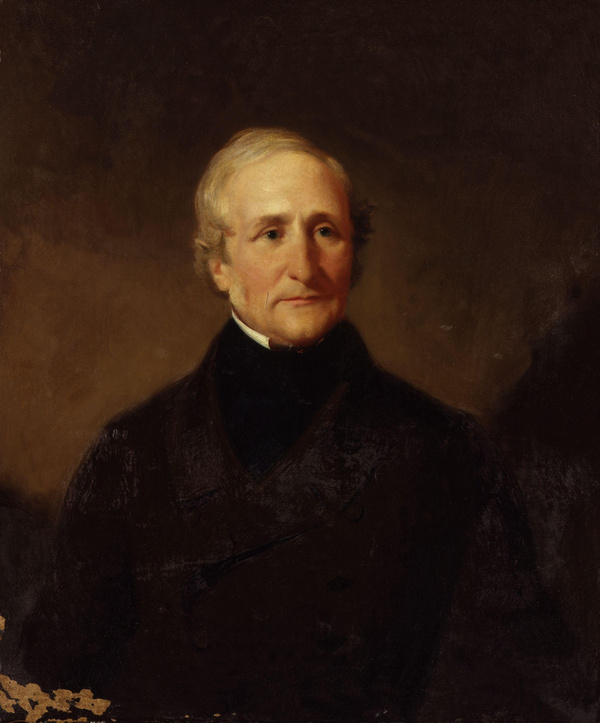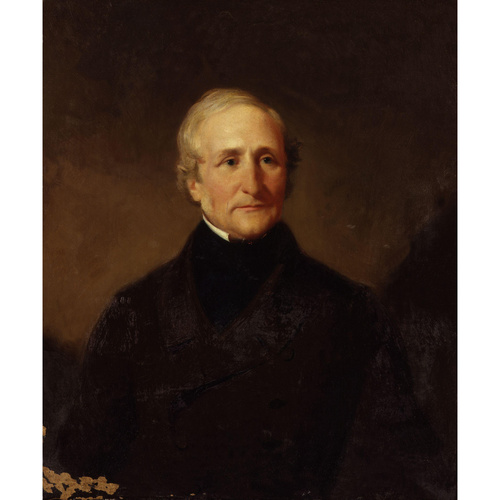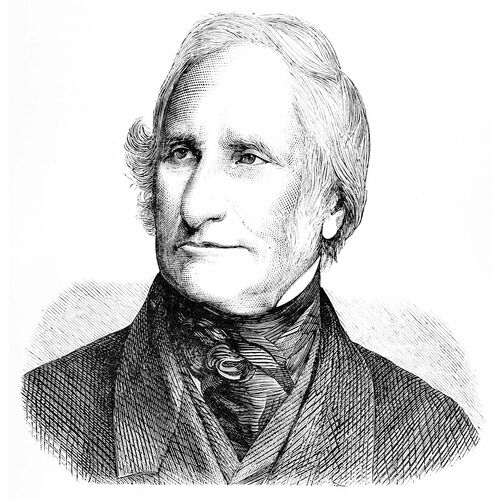As part of the funding agreement between the Dictionary of Canadian Biography and the Canadian Museum of History, we invite readers to take part in a short survey.

Source: Courtesy of Wikimedia Commons
SABINE, Sir EDWARD, soldier and scientist; b. 14 Oct. 1788 in Dublin (Republic of Ireland), fifth son and ninth child of Joseph Sabine and Sarah Hunt; m. 1826 Elizabeth Juliana Leeves; d. 26 June 1883 in Richmond (now part of Greater London), England.
Edward Sabine went to school at Marlow, England, and in 1803 entered the Royal Military Academy at Woolwich (now part of London). He was commissioned 2nd lieutenant in December 1803, and promoted to 1st lieutenant in July 1804. After duty in Gibraltar, he was assigned to the Royal Horse Artillery and became a 2nd captain in 1813. In May of that year he set sail for Halifax, N.S., in the Manchester, which was attacked on 24 June by an American privateer, the Yorktown. After a brisk engagement, in which Sabine distinguished himself, the Manchester was captured. Sabine, released the following month, proceeded from Halifax to Quebec, which he disliked: “If the fortifications disappointed me, much more the town; a more wretched, narrow, filthy place I have rarely seen.” He was placed in charge of a small outpost near Quebec and took part in resisting the American advance on Lower Canada in the winter of 1813–14. In August and September 1814 he served on the Niagara frontier of Upper Canada under George Gordon Drummond*. Sabine was in charge of the batteries at the siege of Fort Erie, and was twice mentioned in dispatches.
With the advent of peace in 1815, men of the British armed forces contributed increasingly to exploration and scientific work. Sabine returned to England in August 1816, and as a supernumerary was able to pursue his scientific interests, especially magnetism, astronomy, and ornithology. He was elected a fellow of the Royal Society of London in 1818 and, on the recommendation of the society’s council, was appointed astronomer to the expedition of 1818 commanded by John Ross* in search of a northwest passage. Sabine performed experiments on the length of the seconds pendulum, noting variations in the period of the vibrations of the pendulum at different latitudes, and thus obtained information about the shape of the earth. He also carried out extensive magnetic measurements, assisted by James Clark Ross*, and made important ornithological observations. Though many of Sabine’s scientific findings were claimed by Ross as his own upon the expedition’s return, Sabine was later able to recover credit for them.
From May 1819 until November 1820 Sabine was assigned to the Arctic expedition of the Hecla, commanded by William Edward Parry*, who unlike John Ross warmly acknowledged Sabine’s scientific contributions. His pendulum experiments on this voyage gained Sabine the Royal Society’s Copley Medal in 1821. He had also alleviated the tedium of the Arctic winter by editing and writing much of the North Georgia Gazette, and Winter Chronicle, published on board the Hecla, which ran to 21 numbers. Between 1821 and 1823 Sabine continued to travel extensively, conducting further pendulum experiments at many different latitudes. On 31 Dec. 1827 he was promoted 1st captain, and from 1827 to 1829 he was given leave from the artillery to act as one of the secretaries of the Royal Society. In 1828 he was appointed one of three scientific advisers to the Admiralty, following the abolition of the Board of Longitude.
Sabine long believed in Christopher Hansteen’s theory that the earth had two magnetic poles in each hemisphere and that there was a correlation between magnetic and meteorological phenomena. Moreover, he believed that the soundness of these theories would be revealed by a systematic and world-wide survey of terrestrial magnetism. In 1830 Sabine was posted to Ireland with his company; he was, however, able to continue his scientific work, and in 1834 began work on what was to be the first complete magnetic survey of the British Isles. James Clark Ross and Humphrey Lloyd of Trinity College, Dublin, also took part in the project. Sabine and Lloyd visited Berlin in 1838 to consult with Alexander von Humboldt, who in 1836 had written to the president of the Royal Society urging the establishment of magnetic observatories throughout the British empire. The society responded favourably to von Humboldt’s proposal, and, prompted by Sabine, advised the government to order long-term simultaneous observations from stations on land and at sea. The observations on land were to be undertaken by the Royal Artillery, initially at observatories at St Helena, the Cape of Good Hope, and Toronto, for a period of three years. The Toronto observatory was headed by Charles James Buchanan Riddell; Sabine undertook the general superintendence of the enterprise.
Sabine was especially active in promoting magnetic observations in Canada. In July 1840 Riddell wrote to him that magnetic and meteorological observations at Toronto had been underway since May. John Henry Lefroy, who replaced Riddell at Toronto in 1842, was directed by Sabine and worked in communication with “the principal cultivators of magnetic science in the United States.” In 1845 he wrote that he had formerly intended to carry out the work personally, a measure of how closely he had identified himself with the North American survey.
The survey was certainly comprehensive. Sabine ordered Lefroy to go north and west of Toronto on magnetic expeditions. He corresponded with Sir John Harvey*, governor of Newfoundland, about observations to be carried out there. He also wrote to Captain Henry Wolsey Bayfield, re, about extending the survey to the northeast, and to Sir William MacBean George Colebrooke* about the possibility of an observatory at Fredericton, N.B. Sabine’s enterprise and skill in organization were impressive – in the winter of 1848–49 he planned to coordinate observations at the Toronto observatory with those at Great Bear Lake (N.W.T.) under Sir John Richardson*, at Melville Island (N.W.T.) under James Clark Ross, and at Barrow Strait (N.W.T.) under Captain Edward Joseph Bird.
Sabine’s representations to the Royal Society, supported by those of Professor Joseph Henry from the Smithsonian Institution in Washington, secured the continuation of the Toronto observatory under the British government until 1853. In 1852, in his presidential address to the British Association for the Advancement of Science, Sabine claimed that the magnetic surveys of North America, sponsored by the British government, had been completed, but this statement was premature and he remained involved in scientific endeavours in British North America. In 1857 he announced plans to extend the survey “between Canada on the East and the Rocky Mountains on the West.” He made suggestions about magnetic observations “for the Expedition proceeding to mark the Boundary in the 49th parallel of latitude, west of the Rocky Mountains” [see Samuel Anderson], and from 1859 to 1861 he assisted Charles Smallwood* of McGill College in obtaining instruments and arranging magnetic and meteorological observations at Île-Jésus near Montreal.
Sabine was active in magnetic studies in British North America, but his scientific aims were nothing less than understanding “the cosmical features of terrestrial magnetism”; that is, he wanted to understand the pattern of terrestrial magnetism, its distribution and variation, and its possible correlation with other geophysical phenomena. Geophysical and other world-wide studies of natural phenomena had many advocates in the mid 19th century. Sabine, however, was one of the few successful promoters of such enterprises. His reputation scarcely suffered even from his advocacy of Hansteen’s erroneous views about terrestrial magnetism or from his refusal to adopt the theory that limited the origins of magnetism to the interior of the earth. Sabine continued to see magnetism as essentially a part of meteorology, and his research programmes were based on the view that different geophysical phenomena were interrelated.
The nature of his scientific interest kept Sabine closely involved with numerous scientific organizations. Besides being president of the British Association for the Advancement of Science in 1852, he was foreign secretary of the Royal Society of London in 1845, vice-president and treasurer in 1850, and president from 1861 to 1871. He was also a fellow of the Linnean and Royal Astronomical societies. Terrestrial magnetism was the subject of 15 papers written for the journals of the Royal Society; indeed, Sabine was the author of more than 100 scholarly papers. He delivered the Reade Lecture at the University of Cambridge in 1862, and was awarded honorary degrees by Oxford (dcl) and Cambridge (lld). Among the many foreign honours he received was the Lalande Medal of the Institut de France.
Although science was his occupation, the army remained Sabine’s professional base and his promotions came steadily, from regimental colonel in November 1851 to general in February 1870. He was awarded a kcb in 1869. Sabine retired from the army in October 1877 on full pay and died at Richmond on 26 June 1883.
[The principal collection of Sir Edward Sabine’s papers, with much Canadian material, is at the PRO (Meteorological Office, BJ 3) (mfm. at PAC). The Royal Soc. Arch. (London) also has a substantial collection of Sabine papers, and there are a few important documents in the library of the Royal Artillery Institution (Woolwich, Eng.). Complementary collections include the papers of Humphrey Lloyd at the Royal Soc. Arch. and at the Royal Greenwich Observatory (Hailsham, Eng.) and of Sir J. F. W. Herschel at the Royal Soc. Arch.
Sabine’s published scientific papers are listed in the Royal Soc. of London’s Catalogue of scientific papers (19v., London, 1867–1925; repr. Metuchen, N.J., 1968), V: 351–54; VIII: 805–6; XI: 251. His works include: An account of experiments to determine the figure of the earth, by means of the pendulum vibrating seconds in different latitudes . . . (London, 1825); On the cosmical features of terrestrial magnetism, being the Reade Lecture, delivered in the Senate House of the University of Cambridge, in May 1862 (London, 1862); Remarks on the account of the late voyage of discovery to Baffin’s Bay, published by Captain J. Ross, R.N. (London, 1819); “Terrestrial magnetism,” A manual of scientific enquiry; prepared for the use of her majesty’s navy: and adapted for travellers in general, ed. J. F. W. Herschel (London, 1849), 14–53; and appendices in W. E. Parry, Journal of a voyage for the discovery of a north-west passage from the Atlantic to the Pacific; performed in the years 1819–20, in his majesty’s ships Hecla and Griper . . . (London, 1821), and A supplement to the appendix of Captain Parry’s voyage for the discovery of a north-west passage, in the years 1819–20: containing an account of the subjects of natural history (London, 1824). He edited Observations on days of unusual magnetic disturbance, made at the British colonial magnetic observatories, under the departments of the Ordnance and Admiralty (1v. in 2, London, 1843–51); and ten volumes of magnetic observations at observatories, including three for Toronto, Observations made at the magnetical and meteorological observatory at Toronto in Canada (3v., London, 1845–57). He also brought together the issues of the journal published on the Hecla: The North Georgia Gazette, and Winter Chronicle (London, 1821; 2nd ed., 1822). t.h.l.]
“Memoir of General Sir Edward Sabine, F.R.S., K.C.B.,” Royal Artillery Institution, Minutes of proc. (Woolwich), 12 (1884): 381–96. DNB. Dictionary of scientific biography, ed. C. C. Gillispie (14v., New York, 1970–76), XII: 49–53. Johannes Georgi, “Edward Sabine, ein grosser Geophysiker des 19. Jahrhunderts,” Deutsche Hydrographische Zeitschrift (Hamburg, Federal Republic of Germany), 11 (1958): 225–39. Royal Soc. of London, Proc. (London), 51 (1892): xliii-li.
Cite This Article
Trevor H. Levere, “SABINE, Sir EDWARD,” in Dictionary of Canadian Biography, vol. 11, University of Toronto/Université Laval, 2003–, accessed March 30, 2025, https://www.biographi.ca/en/bio/sabine_edward_11E.html.
The citation above shows the format for footnotes and endnotes according to the Chicago manual of style (16th edition). Information to be used in other citation formats:
| Permalink: | https://www.biographi.ca/en/bio/sabine_edward_11E.html |
| Author of Article: | Trevor H. Levere |
| Title of Article: | SABINE, Sir EDWARD |
| Publication Name: | Dictionary of Canadian Biography, vol. 11 |
| Publisher: | University of Toronto/Université Laval |
| Year of revision: | 1982 |
| Access Date: | March 30, 2025 |




